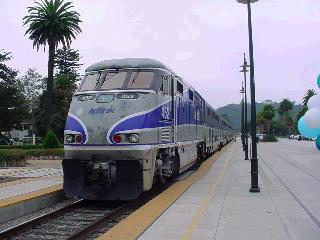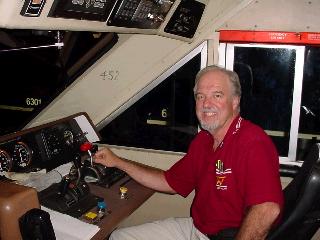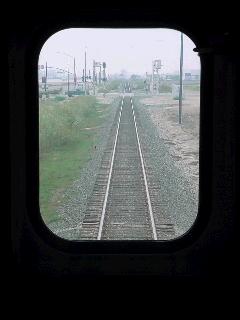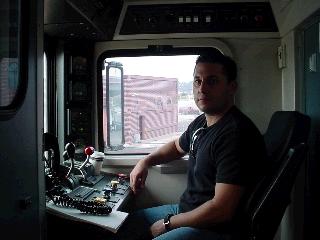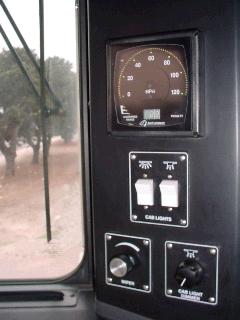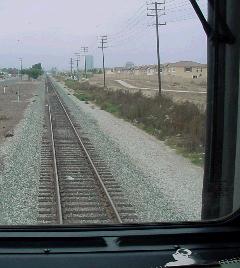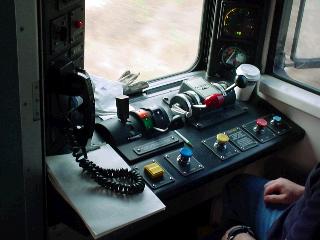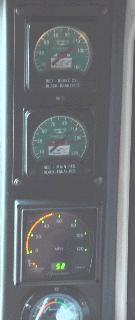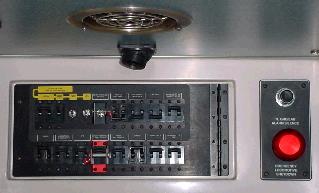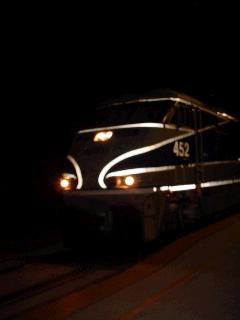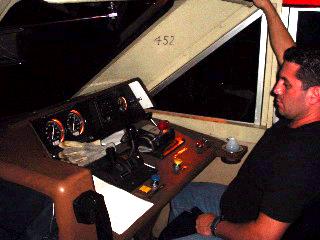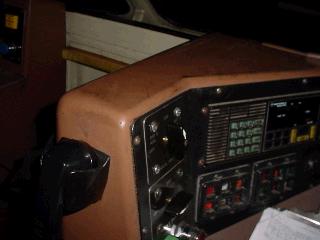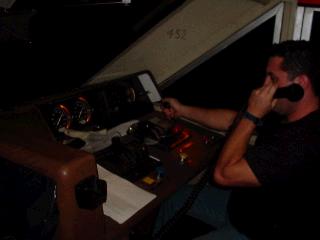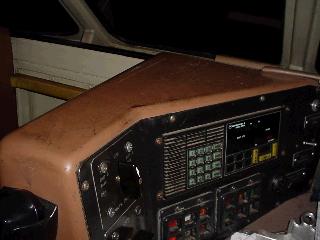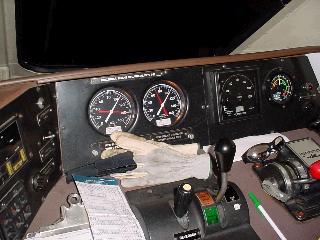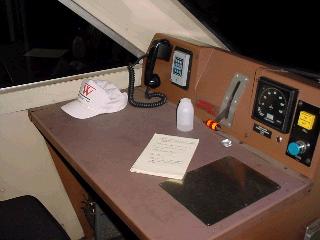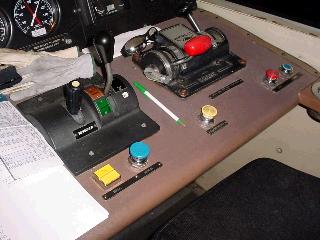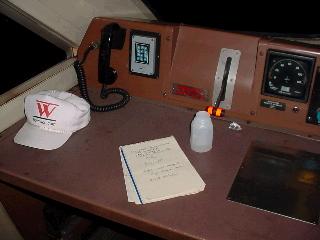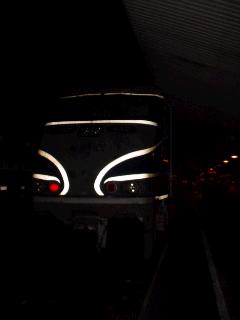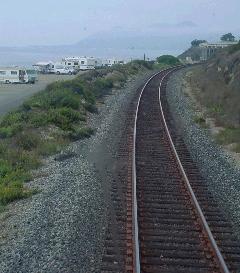
Nearing the ocean
|
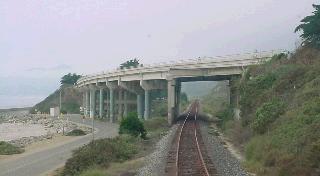
Highway 101
overpass
|
This was my first trip along this portion of
the California coast when I didn't take a lot of photographs. Instead,
I was listening and learning this time. Engineer Leonard Sandoval was
most congenial and informative as I took notes and asked questions. He
became a Conductor in 1997 and an Engineer in 1999. His training included
7 weeks at "Choo Choo U." in Delaware followed by on the job training with
an Instructor. Engineers must qualify on a territory, (memorizing
speeds, curves, and sidings) before they can operate the train on that run.
The Engineer is in charge of the mechanical operation of the train
and is in radio communication with the Conductor concerning any special needs
at stations (such as ADA's onboard or the platform), when it is time to leave
the station he hears"769 High Ball." After such a radio message from
the Conductor, it is "2 Whistles and we're off," says Leonard.
Leonard spent 16 years in the Marines. His goal was to become a
US Marshall. His dad was an engineer. He had a great quote about
why he is now a railroad engineer, "The Career chooses the man, the man
doesn't choose the career."
The best thing about the job is, "I'm not in an office." He liked
his Conductor job also, because he likes people. This was obvious by
the way he treated this 'green horn' riding with him.
He communicates by radio...with the Conductor and Dispatcher and other
trains, and more importantly by the signals along the route. His
communication with the world he is passing is by the train's air horns.
He blows the traditional 2 longs, a short, and a long which is held
until the engine is on the crossing. He knows when he is approaching
a crossing by "W" or "X" signs along the right-of-way. If there are
numbers on the same sign, like "1/4," they are alerting the engineer how
far it is to the next crossing. Without the numbers, the engineer
knows he is to start blowing the traditional horn pattern 1/4 mile ahead
of the crossing. If there are numbers on the signs, such as "X/2" or "W/2"
that means there are two close crossings ahead. He also communicates
with track workers and members of the public with a wave and a couple of
toots of the horn to acknowledge that he has seen them waving.
Cab Ride in Engine 452 from Santa Barbara to Los Angeles. 7
p.m. to 10 p.m., September 30, 2003
When the horn is blown, it activates the two bright, alternating ditch lights
on the front of the engine, and activates the bell. Both the ditch
lights and the bell stop automatically about a minute after being activiated
and the main headlight stays on throughout. The Engineer can activate
the bell without blowing the horn. The bell is on for stations and
for passing engines instead of the horn. He would like to be
able to turn off the ditch lights before the pre-set wait time so that approaching
trains don't have to be blinded by his lights. I was glad this cab
ride was after dark or I wouldn't have noticed all these factors. California
law requires that he blow the horn at all crossings, private or otherwise.
Crossing arms are set by the speed of the train and all were working
as we traveled through the night. In case one isn't working, the Engineer
stops the train and the Conductor walks into the intersections and observes
the train passing and the stopped traffic.
Leonard also is an Engineer on the Southwest Chief between LA and Kingman.
One difference between the Surfliner engine and the Genesis is a
little bit less visibility in the Genesis because of the large portion
of solid body between the windshield and the side windows. Also, since
the SW Chief has the 'Express' freight cars on the back, the brakes are
different. Passenger trains have "graduated release" brakes where
the air is recharged quickly. Freight trains (or passenger trains
with freight cars like the Southwest Chief) have "direct release" brakes
where all the air is used in one application and must be recharged before
use again. I asked Leonard about the old 'Dead Man's Switch"
that I'd heard about on steam engines when I was a kid. He said that
they found that it was ruining engineer's legs having to have their foot
on a petal, holding it down, their entire work shift and discontinued it.
Modern engines, however, have computers that would stop the train if
their was a problem with the engineer not being able to complete his work.
As we pulled into a station and stopped, I asked Leonard how he knew
where to place the engine. This is part of having the route memorized.
That particular station stop, Leonard wanted the last car in the
set to be past the nearby crossing so traffic wouldn't have to stop during
his time in the station. Other stations might have a sign at eyelevel
to the engineer stating where to spot the cab, but the length of your train
that day would need to be considered and which train you are running, Metrolink,
Surfliner, Amtrak SouthWest Chief, etc.
I was seated in the "Second Engineer's" seat for this cab ride, and Leonard
showed me a 3rd jump seat. On onernight runs there is a Second Engineer
who would be in my place. Engineers have a 6 hr. limit of "Throttle
Time." DOT has a limit of 12 hr. shifts with 10 hrs. rest, or if
less than 12 hrs., 8 hours rest. A motel room is provided for the
'rest' time. The run from LA to San Luis Obispo is 6 hours, by with
one engineer there is no time for a break, even a restroom break. Of
course, an engineer can stop the train for this activity, or, as on this
trip, while on a siding, take care of business at that time.
Leonard is on the 'Extra Board' and can be called for jobs on any route
on which he is qualified - San Diego to San Luis Obispo - the Southwest Chief
to Kingman, or yard work.
This Surfliner F-59 engine is 3,000 horsepower with 4 traction motors.
The diesel engine generates direct current for the traction motors.
Every six months an inspector rides along with the engineer to observe
and ask questions and, if satisfied results, renews the engineer's license.
Along the route south of Santa Barbara are some wires Leonard called
'slide detectors' that, if bumped or broken by a landslide or falling rocks,
would alert the railroad and engineers.
There is a 79 mph speed limit in many parts of the US, but there is a
spot west of Kingman where the limit is 90 mph.
At one slightly rough spot in the cab ride, Leonard said even the same
model of engines ride differently. They need the shocks changed now
and then just like a car.
Signals vary with the railroad on which you travel, necessitating the
law that you carry a pack full of rule books and refer to them when needed.
Signal lights are not consistent, but on our part of the railroad
a signal with a number is telling you how the next signal is set. Signal
blocks are approximately 2 miles long in California. Engineers are
required to stop 400 feet from a red signal and wait. In our case,
we were ordered to a siding and Leonard pulled to within 400 feet of the
red signal until the approaching engine went by and the signal changed (and
the switch was remotely changed) so we could go back on the main track.
There are many 'detectors' along the railroad, you may have heard the
automatic one responding as you pass if you carry a radio while traveling
by rail. There are 'High Wide' detectors on sections of the railroad
before tunnels.
Leonard is considering writing a cookbook of Railroad Engineers' favorite
recipes for meals that can be cooked on top of the engine!
He also related that the best place to learn history about railroads
is the History Channel. In fact, when I asked him why the engineer's
controls are always on the right side of the engine, he said, "I don't know,
but I'll bet you can find that out on the History Channel."
As our journey (
adventure for me) neared its end in Los Angeles
Union Station, I began a list of
WHY IT IS HARDER TO DRIVE A
TRAIN FROM LOS ANGELES TO SANTA
BARBARA THAN AN
AUTOMOBILE:
- You have to blow the traditional horn blast for each crossing
and you would be surprised how many crossings there are
- You have to slow for curves, unlike an Interstate built for
over 65 mph
- You have to read signals correctly as to whether to proceed
into the next block
- You have to watch for pedestrians, bike riders, and vehicles
adjacent to the tracks or crossing the tracks
- You have to watch for workers and know where they will be
according to written orders you receive before you leave on your run
- You have to watch the mile markers and know which ones for
which you have written orders that require you to slow or stop
- You have to know the differences in the signage and signals
of the railroad on which you are running
- You have to stop at many stations and stop at the right spot
for passengers to detrain or load
- You have to be aware of the schedule so you stay on time
and do not leave before your departure time
- You have to to call in signals as you pass them so the dispatcher
knows where you are on the run
- You have to communicate with the dispatcher and conductor
on the radio, often repeating orders you've received
- You have to watch the many speed limits posted for passenger
(on the left) and freight (on the right) trains of each sign and obey them
- You have to be able to drive the train watching the ground
if it is so foggy you cannot see beyond the windshield.
- You have to watch the controls for air pressure etc.
- You have to start and stop smoothly so passengers are pleased
with the ride
And, you have to do all this
safely so that your cargo
of passengers is not harmed and you will have your license renewed for another
six months.
